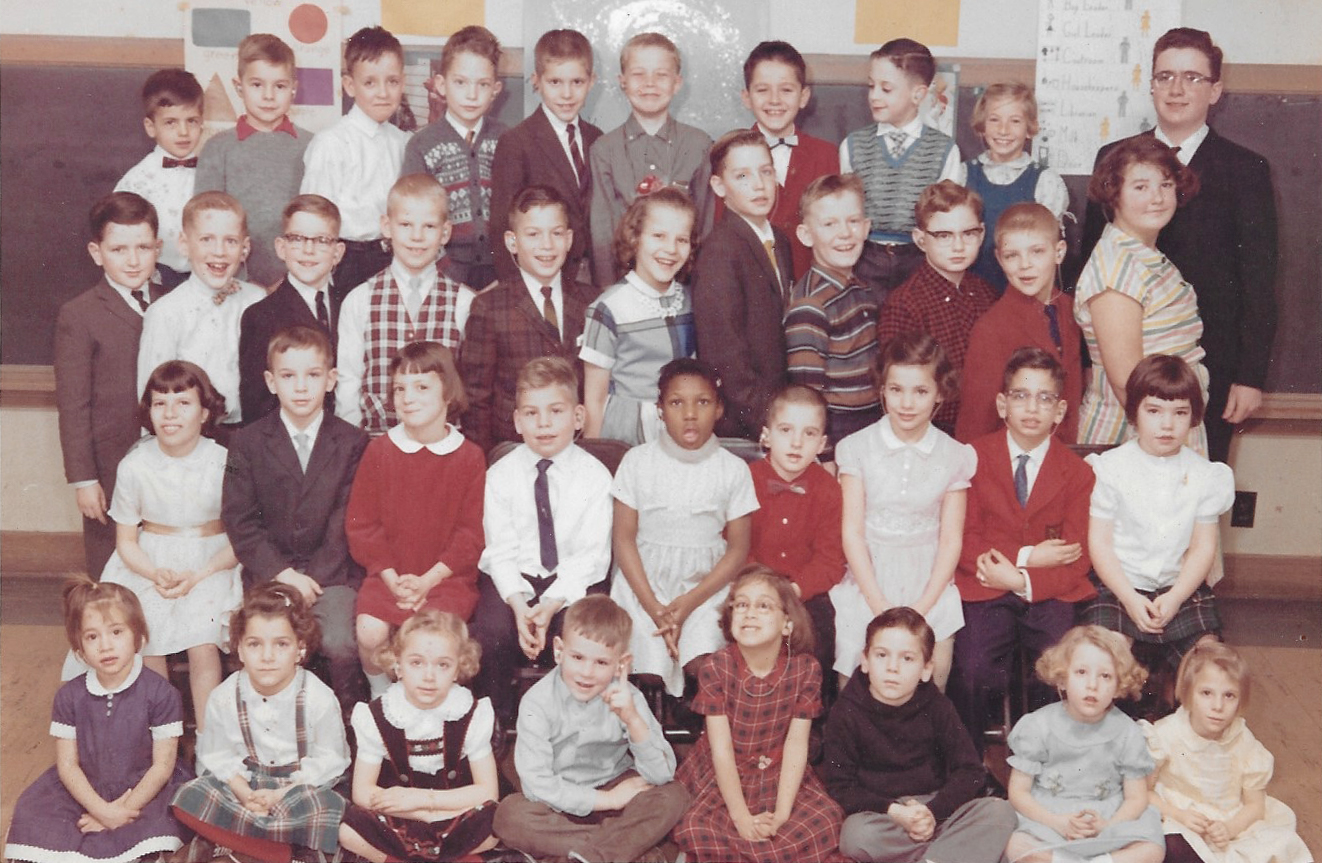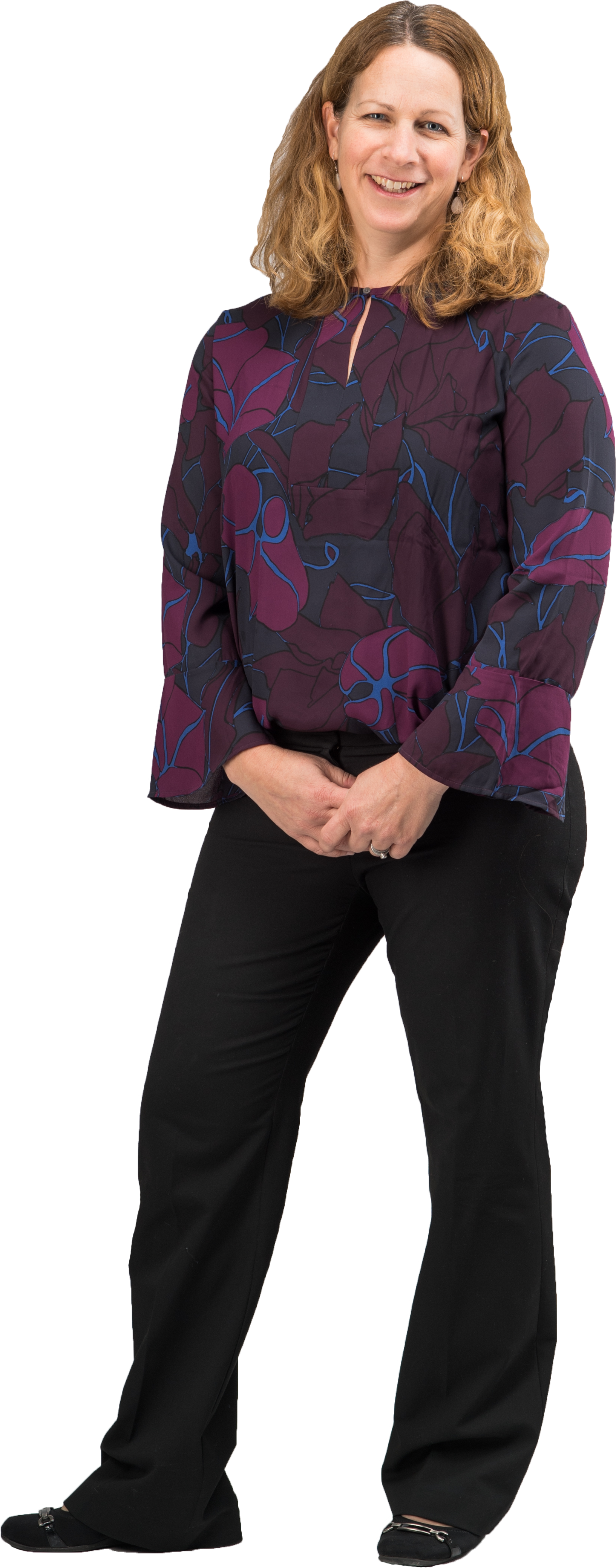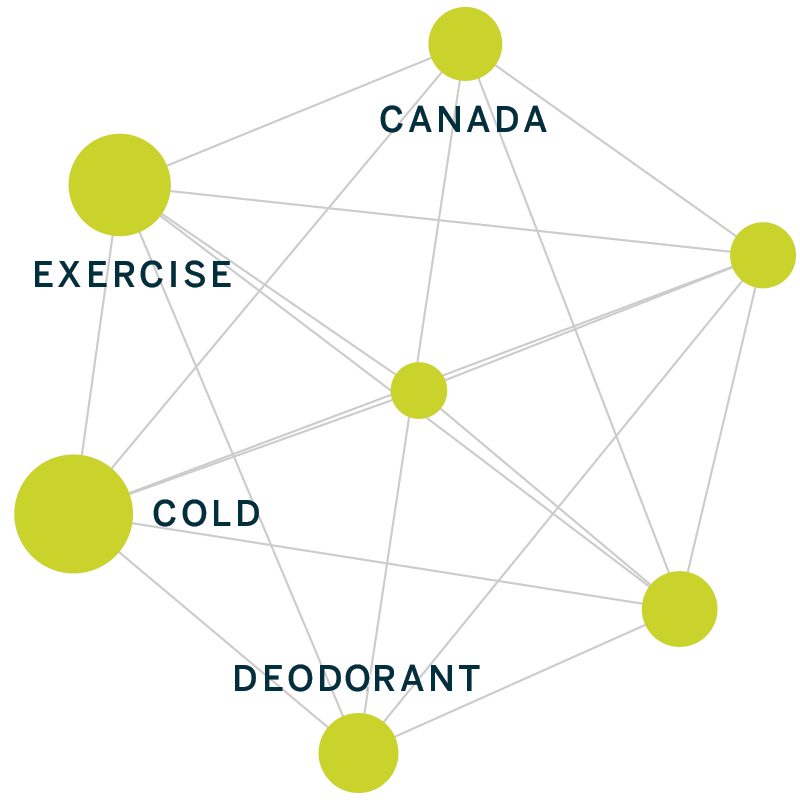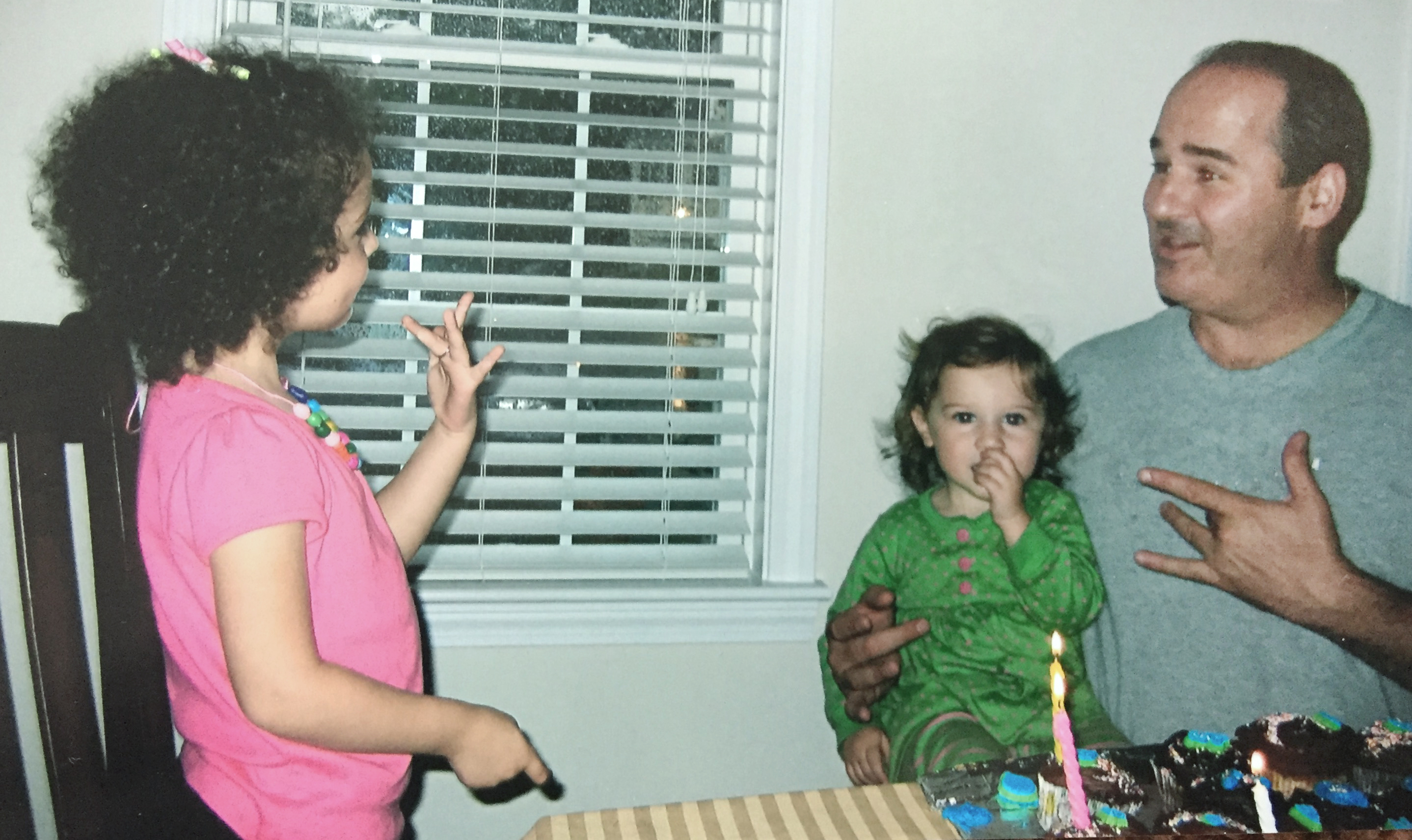what percentage of deaf children are born to hearing parents
Getting the Word In
BU Deaf Studies researchers wait for ways to prevent deaf children from being deprived of language.
A few years ago, Naomi Caselli, a Boston University Deaf Studies researcher, stumbled upon her father's faded class picture from the 1960s. He stood in the back, a suited adolescent in a sea of elementary schoolchildren. Caselli assumed he was a teacher's adjutant.
He wasn't. Her male parent had been held back.
He had lagged behind his peers for a specific reason. Caselli's father, Raymond Kenney, is profoundly deaf in both ears. He was in a course for deaf and hard-of-hearing children, but they didn't teach sign language at that place. Instead, teachers spent years coaching him to speak using concrete and visual cues. Over and over, they sounded out words like 'brawl,' repeating 'bah-bah-bah' while holding his mitt at their mouths to show him how to mimic the vibrations. "They really wanted him to speak," says Caselli.

By age 8, he knew a few basic words, but he could not speak in sentences and used made-up gestures to communicate with his family. He did larn to read, however, and excelled in math and science as a teen.
At historic period 19 at the National Technical Institute for the Deaf at the Rochester Constitute of Technology, he got his beginning await at American Sign Language (ASL) in practise among other deaf students. "I was enthralled," says Kenney, who immersed himself in learning the language. "A lightbulb went on."
Today, he notwithstanding struggles with reading and expressing himself in written English, frustrations that evoke his childhood, when his power to communicate was then limited. "I'chiliad still connecting to that anger," says Kenney, who is now a Certified Deaf Interpreter.
"He'southward a beautiful signer at present," says Caselli, who is hearing simply learned ASL alongside spoken English from birth. "But that's uncommon for people who've had a similar experience."
Today, ASL has been accepted every bit a total-fledged linguistic communication with all of the complexity, construction, syntax, and storytelling found in spoken languages. As well, elementary and secondary school programs for the deafened teach and assess ASL proficiency using accepted measurement tools, some of which were developed at BU.
Merely language impecuniousness remains a real problem for deaf children. "Kids today are still having much the same experience that my dad did," says Caselli. "It is not a thing of the past."
Many deaf children—perhaps equally many as 70 pct—are deprived of language
Photo by The Learning Center for the Deaf
The business concern now amongst researchers similar Caselli and Amy Lieberman, assistant professor of deaf studies in the BU School of Education, is what happens before schoolhouse starts. Approximately ninety to 95 percent of deafened children are born to hearing parents who often don't know sign language and therefore will likely struggle to teach it before their children enter schoolhouse. Even among schoolhouse-aged deaf children, estimates based on data from a 2010 survey from Gallaudet University, which specializes in deaf education, suggest that at almost 40 percent of families use sign language at home. Given this data, educators in the field worry that a majority of deaf children may be deprived of language.

Exposure to language from nascency is essential for the development of thinking skills, according to a range of studies. Without access to linguistic communication, children accept a harder time in schoolhouse. They also have more difficulty developing a sense of self and others. They even struggle with planning and time direction. "It's a constellation of challenges," says Caselli.
Then Caselli, Lieberman, and their collaborators are using the tools of linguistics, behavioral psychology, cognitive science, and education to empathise how deaf children acquire language and, in turn, how best to teach them. "We desperately demand information most this," she says. "We are still at the kickoff stages of identifying the most prevalent problems."
Critical Moments
When Robert Hoffmeister founded the BU Deaf Studies program in 1980, ASL was on the fringes of credence. Students at BU could study it, but it did non count as a foreign language. "That'due south the cloud we lived under for about 25 years," says Hoffmeister, associate professor emeritus of deafened studies. "That cloud was more or less lifted past evidence-based research."
Linguistic analyses showed that ASL is a language, not just a bunch of gestures. It uses space, coordinated handshapes and movements, facial expressions, and a unique syntax to build meaning. Together, this visual language has all the structural features plant in spoken languages. Information technology also has its own literary traditions. "Nosotros have folklore passed down from generation to generation," says Bruce Bucci, a BU Deaf Studies instructor who is among several deafened faculty members at BU and communicated through an interpreter for this story. "There is a visual tradition and culture continued with the language."
Acceptance of ASL equally a language was a cardinal first footstep toward preventing language deprivation, considering it validated the instruction of ASL to deaf babies and children. The developing brain responds to linguistic communication no matter how it is presented, so exposure to ASL is equivalent to exposure to a spoken language. "The same brain regions and mechanisms perceive and larn language regardless of the modality," says Lieberman.
At most, 40 pct of families with schoolhouse-aged deaf children employ sign language at home
Photo by Cydney Scott
Researchers also learned that language deprivation delays the development of thinking skills. In 2007, Hoffmeister and colleagues studied deaf children'due south development of "theory of heed," the homo ability to think about other people's thoughts. They constitute that children exposed to sign language from nascence develop theory of mind apace with hearing children. Just children with delayed linguistic communication exposure also had delays in theory of mind. "Y'all need language to talk about the world," says Hoffmeister, who hears simply is a kid of deaf parents. "Language was the crucial factor."
Hoffmeister went on to develop ways to assess language acquisition in school-aged children. At present research in the Deaf Studies program is shifting the focus to younger children, from birth to age v. This historic period range is known as the critical menstruum of language development. During those years, exposure to language triggers all kinds of development. Pull the trigger, and children acquaintance words with things, ideas, and feelings. They course a sense of self and others, an agreement of time and planning, and an ability to pay attention and make connections.
On the flip side, without language exposure, children experience a cascade of deficits. "If babies don't have stimulation with language during that critical fourth dimension of development, then their cognitive development, their thinking skills, and their language evolution are all at pale," says Nicole Salamy, a speech and language pathologist at Boston Children's Hospital who is as well a deafened studies instructor at BU.
Bucci puts it more straight: "If children are deprived of language, they will not thrive."
The problem is that for deaf children, language is visual. It'south not passively absorbed as the sounds of life occur around them. "When deaf children have access to visual language, they can navigate their world right abroad," Salamy says.
"If children are deprived of language, they will non thrive."
Bruce Bucci, deaf studies teacher, Boston University
Language Barriers
Hearing parents of deaf children confront all of the challenges of parenthood plus the need to acquire a completely new linguistic communication for communicating with their child. They also face conflicting communication from wellness providers, associations, and educators.
Some advocacy and professional groups counsel confronting introducing sign language, specially targeting parents who want to use medical interventions such as cochlear implants. Parents are told that sign language will distract their child, or that it will take up space in the brain and not exit room for learning spoken languages.

These and other concerns have largely been debunked. In a recent review of enquiry on the subject field, Caselli and her colleagues, Matthew Hall from the University of Connecticut and Wyatte Hall from the Academy of Rochester Medical Center, show that learning ASL early supports learning a spoken linguistic communication later, the same way learning one spoken linguistic communication supports learning a 2d. "If you understand the structures of 1 language, you'll be able to use and empathise them in some other," she says.
In that location is also a notion that deaf children struggle with reading because they can't sound out words. This connexion between written language and sounds is called phonological coding. Simply co-ordinate to research Lieberman did before she came to BU, this is also a misconception. "Many skilled deafened readers practice not accept access to phonological coding," she says. "They clearly have alternating routes to reading, virtually likely having a foundation in sign language."
Ultimately, there is no take chances to introducing children to sign language. Research shows that the deaf child will only benefit, whether hearing and oral communication are introduced subsequently or not. "Yous can do both," says Caselli. "You can learn sign language and try to get spoken language."
I of the biggest challenges for educators and researchers who desire to improve deafened education is figuring out how to detect linguistic communication deprivation. This would not but help researchers empathise the calibration of the problem simply as well aid them guide deaf children and their parents to services that tin smooth the mode to introducing sign language.
90 to 95 percent of deaf children are born to hearing parents who often don't know sign language
Photo by The Learning Center for the Deaf
A starting time step, being taken past Caselli, Lieberman, and Jennie Pyers, a visiting faculty member from Wellesley Higher, is to develop an ASL test for children nether 5. With new funding from the National Constitute on Deafness and other Communication Disorders, role of the National Institutes of Health (NIH), they program to work initially with deaf children who have deaf parents. "We desire to sort out what vocabulary acquisition looks similar under ideal conditions," says Caselli.

From there, they will study deafened children with hearing parents, who likely face bigger challenges and potential delays equally parents learn to sign. "Our goal is to determine where children fall behind and where they don't, so that we can focus interventions," she says.
To support this endeavour, Caselli developed an online visual lexical database for ASL called ASL-LEX. The tool, which won the People's Choice Accolade (Interactive Category) in the "Vizzies" Visualization Challenge sponsored by the National Science Foundation and Popular Science, documents about one,000 ASL signs, along with information most frequency of use, grammar, and paw movements. The database will too become a repository for information nigh milestones, such equally the age at which children acquire different signs. This information, in turn, can go a source for edifice assessment tools.
Attending-Getters
For parents of deafened children, chore one—aside from learning the language itself—is getting the child'southward attention. "It seems simple, but parents need to larn how to manage their child's gaze," says Lieberman.
Deaf babies who learn sign language from their parents learn to manage their attention by the time they reach preschool, according to earlier research by Lieberman. "They look up to run across a sign and downwardly to connect the sign to an object," she says. "They do and then in meaningful and purposeful ways."

Since eye movements reveal a lot about how deafened children procedure and acquire language, Lieberman adult a fix of studies using techniques that rail eye movements and is continuing this research with a grant from the NIH. She and her research team, which includes both deaf and hearing researchers, are focused on deaf children as young as 18 months and upwards to five years to empathize how and when they acquire words.
The report will include both deaf children with deafened parents and deaf children with hearing parents. "We want to look at the full spectrum of deaf children, looking carefully at the quantity and quality of language exposure they're receiving," says Lieberman. "How do those two measures correlate with the ability to develop visual attention skills and new words?"
Not only will this research assistance develop milestones for detecting language impecuniousness, it will too help develop interventions for children who are falling behind. An outcome could be an educational programme, or tips for parents that help them manage their child's gaze. "Without looking, there'due south no linguistic communication," says Lieberman.
Explore Related Topics:
Source: https://www.bu.edu/articles/2017/asl-language-acquisition/
0 Response to "what percentage of deaf children are born to hearing parents"
Post a Comment